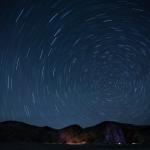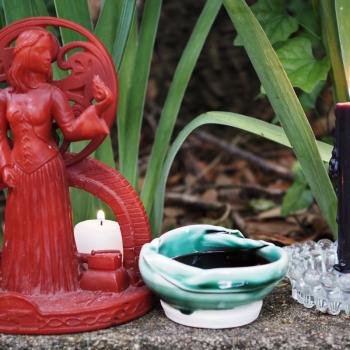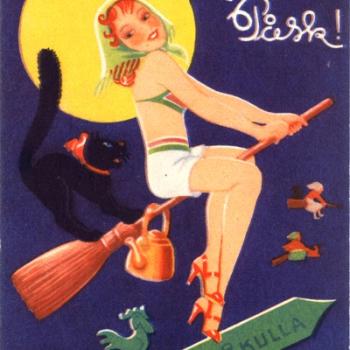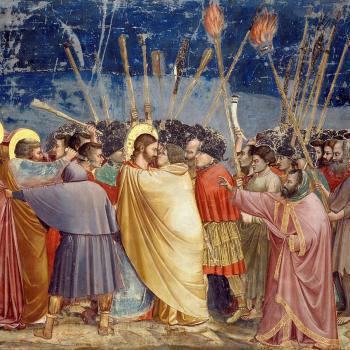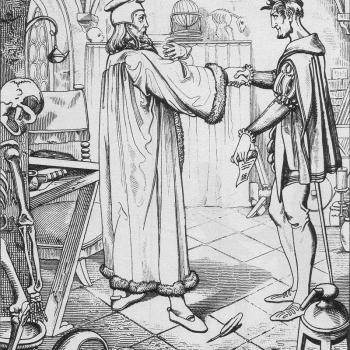Or how to tread the mill

There are three rings of power that are distinct and often referenced by those adherents to a traditional witchcraft deriving from the works of Robert Cochrane, sometimes conflated and confused. Within the writings of Cochrane there is made use of terminologies that have become incorporated as general canon of traditional witchcraft. In the document known as the Basic Structure of the Craft among students of his work, Cochrane makes plain that there are five circles, or ‘rings of power’ which are to be studied by the would be witch in an apparent lesson plan that was never completed.
The first ring that Cochrane discusses in this lesson outline, and to which he often makes reference within the letters to American founder of the 1734 traditition of witchcraft, Joe Wilson, is the Wheel of Life, sometimes also called the Greater Wheel. For purposes of ease, we shall simply refer to this ring as the Wheel.
The Wheel is the basic creation of witch magic…
With this introduction to the topic of the Wheel, Cochrane goes on to explain that it is the principle starting point, the point of worship of the five-fold Goddess and “…it’s main use is in rituals of Death and Resurrection”(Monmouth, 2012). In this brief description of the central ring, which comprises a spring board for many other rituals, there is a wealth of possibility when understood as the Compass in its place. As the vehicle of the Horn Child, and also referred to in a letter entitled The Gathering of the Greater Congregation (Monmouth, 2012) we see that Cochrane invoked this Wheel with“Invocation of the Twin of the South” and as a “Sacrament to Our Lady.” This confirms his earlier assertion in the Basic Structure description of the Wheel as a “vehicle of worship of the Goddess…” (Monmouth, 2012).
This particular Wheel is worked sunwise and, so he tells us, never widdershins, nor for cursing or baleful magics. In the strictest sense, this is the wheel of fertility, remembering that Cochrane also insisted that all magics work in a formula of fertility, vitality and inspiration. Therefore, this is worked with the direction of the sun/son and in honour and worship of the Goddess in her five-fold aspect as Life, Love, Maternity, Wisdom and Death.
Within the centre of the Wheel, a fire may be built creating the “…rose of passion, or unity” and it is enclosed with salt and chalk, “that is life and the power of the moon.”(Monmouth, 2012). Within the centre, Cochrane also states that there is a heart within a coffin, or as “…it is known in the Craft, the Rose from the Grave”(Monmouth, 2012).

This symbol appears in correspondence with Norman Gills, where it is represented as a small heart within a diamond square. In this particular letter, Cochrane presents one of his famous riddles, with pictograms which Gills is challenged to translate. This has become a task undertaken by many, with interesting results. This symbol is one which follows the words ‘phases of the moon’ and, within the cache of material from Normal Gills held at the Witchcraft Museum, Cornwall, is a paper headed Symbols of the Craft, presumably written in Gills’ hand. In this document, the same symbols are given and the heart and coffin pictogram is identified as ‘phases of the moon’. We are reliably informed in one letter from Cochrane to Joe Wilson that the three moons represent Life, Love and Death/Wisdom and are seen in the Virgin, Mother and Hag aspects of the lunar phases (Cochrane and Jones, 2002). This is the simplest explanation of this symbolism.
Now, in its use the Wheel forms the basis of witch operations in the workings of Robert Cochrane, being the magic Compass representing the ‘middle-world’, or the realm of present upon the Earth. Therefore, it is the vehicle because it is in motion, as the sun and stars circumnavigate the skies, and the Horn Child, the Twin Luci(fer) in His progression through the knots of the Round of Life. This realm is subject to, and encoded within the Round of Life are, the seasons and festivals, the passage of time and tide and under the aegis of Herself.
The Wheel is used to draw the moon in workings which incorporate its energies, whereby the Maid or Lady uses a reflective surface to project the moon into the mirky waters of the cauldron or horn cup. This task is often performed at the stang, with the intention of reflecting and drawing the lunar Goddess into the potion within the pot. Thereby is She invoked into the Cauldron of Inspiration, from which the sacred drink is taken. This “is a necessary preliminary to the finding of truth.” (Monmouth, 2012).
The ritual of the Cauldron as a necessary prelude before progressing to the Moat and Mill pulls together various strands of witch folklore and memory, adapting deftly the symbolism and mythology in one fell swoop. Here we see the myth of Taliesin, the Preiddeu Annwn, the three witches of Shakespeare’s Macbeth, as well as many a folklore image of witches dancing about a cauldron, all sewn into this one ritual. In this capacity, if Cochrane did not inherit this genius, he most certainly was inspired by it.
So, within the Wheel, if the purpose of ritual is to move from worship to magic, and Moat and Mill are to be attained, the Cauldron provides the draught that allows the living to descend the Land of the Dead and return. This, Cochrane asserts, is what separates the witch from the pagan: the witch crosses the river that separates the quick from the dead and the pagan does not, remaining in the Wheel in celebration and fertility rites. Therefore, the Wheel is the absolute ring of worship of the Gods in complexity and simplicity itself, with a depth of wisdom and knowledge, and an entire formula by which it becomes the vehicle, never still, and the launch pad for further magics.
“…the fire of masculine intellect boils the cauldron of feminine inspiration… then and then only do we proceed to the circle where we offer the taper of intellectual awareness to the banner of truth.”(Monmouth, 2012)
In his letter to Wilson, Cochrane notes that, taken together, they provide the reader with the structure and purpose of the ritual of the cauldron, in which one is “…girded and can administer the Water of Life to your family”(Cochrane and Jones, 2002). Finally, it is this which Cochrane identifies as the ‘basic ritual of the Faith’.
The Moat and Mill
Whilst many undertake to ‘tread the mill’ whilst in the Wheel, I am of the view that this is, in fact, incorrect according to study of the Cochrane material. At this juncture, within the Wheel, that is the first Ring of Power, one would use one of the various ‘Dances’ of worship depending upon the Sabbat. Whilst some of these might be construed as similar to the Mill, this is actually a separate Ring in itself as is the Wheel and Moat. Indeed, the Moat and Mill are so intrinsically linked that Cochrane sometimes refers to them as such. The reason for this is that the Mill is, of course, Hamlet’s Mill and belongs properly within the star map of Dame Fate.
One clue is in the article written by Cochrane and published in New Dimensions magazine (Vol. 2 No. 10) in November 1964. This piece gives an outline of the basic ritual and it is evident that the dance performed before the cauldron, that is in the Wheel, in this particular writing is called the Maze.
Before the Compass becomes the Mill, it must first become the Moat. The Moat is finally activated when the contents of the cauldron are discharged and form the ditch which bounds the ring. Thus, the sacred drink is also the river, as can be seen in many ancient mythologies, including that of the river Lethe to which Cochrane often alludes. Traditionally, all those who sup for the Lethe experience complete forgetfulness, and it might be a reference to those trance states whereby we often have little awareness or remembrance upon return to normal states of consciousness. Just as dreams evade capture upon waking, so too might our vision of the otherworld if it is not diligently recorded in time. However, initiates of the Orphic Mysteries were commanded to drink not from the Lethe, but from the river Mnemosyne which brought remembrance, especially anamnesis.
Following ritual procedure, we move from the Greater Wheel to the Moat and the Twin of the North (“who all true magicians work with at any decent level”), crossing the now bridged river fashioned by the ditch (Monmouth, 2012) and the river of liquid born from the Cauldron of Inspiration. Having entered toward the Underworld, it is incumbent upon us to summon the guide in order to traverse these realms safely. This is performed with the secret Summons and Word, following which the Moat becomes transformed again and in the Mill and we can see how the two rings are intricately woven and dependent one upon the other. Now commences the “Mill or grinding of fate… widdershins, Summoner leading.” (Monmouth, 2012)

Working the Cosmic Mill
The metaphor of the Mill for the procession of the stars and constellations, enacting a mythic dance about the cosmic axis, is one which has been alluded to many times before. As the polestar denotes the celestial centre, reflecting the chthonic axis mundi of mythic histories, we can draw a line between the earthly and heavenly through the Northerly compass point. This ‘North Star Road’ has been identified by shamanistic practices proposed by many to have ancient precedent, being the route to the heavens and, paradoxically, the underworld realms of mythic gods and heroes. These same underworld gods and heroes were cast upon the stars to play out a cosmic dance above, mirroring that which occurs upon the earth. The Cosmic Mill, Heavenly Mill, Hamlet’s Mill, and many other cutural variants, plays upon the myth that the heavens represent a celestial millstone which is rotating upon its axis, grinding the fate of our lives like corn. This analogy, which appears in many cultures over the years, and has been subject of exploration by mythographers and anthropologists since the mid nineteenth century, bears significant import. Regulating the seasons, the passage of time, as well as the journey of the heroes cast among the stars, the Mill grinds out our Wyrd as the rota fortunae, and it is only here, having drank deep of the cauldron and crossed the river of Time, may we work it.
This metaphor is significant to us in that the treading of the mill in the traditional sense would relate to the canopy of the heavens and the underworld journey, where fate is meted out at the foot of the Cosmic Tree, representing another axial symbol. Having crossed the river of Time, it makes little sense that we would be working the mill upon the earthly plane of fertility, life, love and death, the ring which is fastened upon the knot of Death. Rather, it is upon the plane where the Castle may be found that we have travelled to, beyond the mundane where we engage in the works of fate, Divine Providence, to where works of magic may take place. That is, we have transcended the Wheel of Life, crossed from the quick to the dead, and are engaging Fate directly.

The Return
Little is left now but to return to the Moat and Wheel, crossing back to the land of the living, where the Horn Child is born, dies and is reborn, having worked with his Dark Twin. This simple, subtle and difficult outline will no doubt cause opposition, prove controversial and scatter the pigeons with a well placed cat. With no apology, it is hoped that we might think differently when we next talk about ‘treading the mill’, and find in these three rings of power some essence of magic as understood through the lens of Cochrane’s craft.
Robert Cochrane Letters copyright estate of E. J. Jones
Bibliography:
Cochrane, R. and Jones, E. J. (2002) The Robert Cochrane Letters: An Insight into Modern Traditional Witchcraft. 1st edn. Edited by M. Howard. Capall Bann Publishing.
Monmouth, J. of (2012) Genuine Witchcraft is Explained. 1st edn. Capall Bann Publishing.


